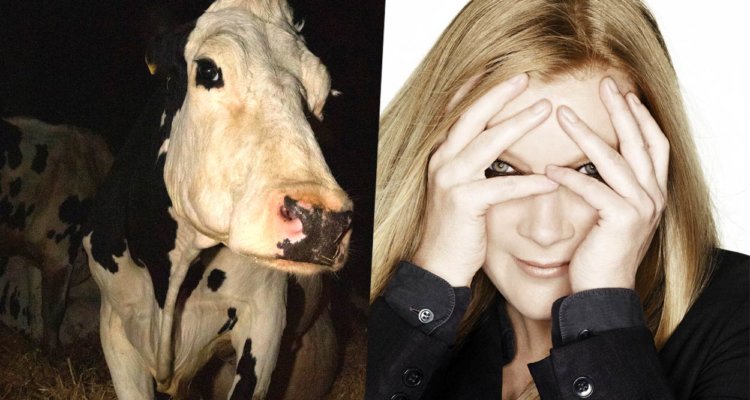Andrea Arnold is aware that cows roaming the countryside is an image cut straight from the cloth of pastoral English iconography, the stuff of Victorian novels and Renaissance paintings. “[For] a lot of our modern lives, our sort of view of nature is a very romantic one,” she says. “It’s a very sort of postural, are we going to have a picnic and a nice bit of nature? We engage with the romance of it as opposed to the reality of it.”
READ MORE: Best Of Cannes 2021: 15 Must-See Movies From The Festival
The reality of nature, in all its unglamorized truth, is the driving force of Arnold’s new film, “Cow,” which premiered at the Cannes Film Festival. Ninety minutes, observational and almost entirely wordless, “Cow” follows Luma, a dairy cow whose existence is defined by an infinite cycle of calving and yielding milk. Watching, witnessing the film even, is a quiet but stark exercise in extreme empathy, as Arnold’s single-minded focus on bovine characters imbues Luma with perceptible personhood. She becomes a creature with desires, fears, and feelings. “I think I realized early on that her eyes were everything,” Arnold says of the film’s cinematography, helmed by DP Magda Kowalczyk. “You could really see her… I realized that [the goal was] to stay with them and just be with them in their experience.”
Allowing the cows to take center stage without the assistance of narration is an unconventional approach to documentary filmmaking—if you can even call the film a documentary, a label that Arnold herself shies away from. “It’s not really a documentary. I don’t think it is. I don’t know what it is, but it’s not a documentary,” she says. When pressed for more detail, she considers. “I don’t know why it’s not,” she says. “What is a documentary, maybe?”
It’s hard to say. “Cow” is certainly not fiction, but it also doesn’t feel like a documentary in a traditional sense of the genre. Its style combines a cinéma vérité spontaneity and a studied, edited intentionality, periodically cutting away from the cows to show airplanes gliding through the night sky with the distant echo of the train. The modes of transportation, Arnold explains, are meant to telegraph the alienation of human spectatorship. “That was, for me, about connecting to us. With airplanes and trains, normally, we’re on the train, not looking at the cows. Basically, it was like we were the cows, looking at the train. So it’s a reflection on us and how we see them.”
READ MORE: Did The 2022 Oscar Season Kickoff In Cannes With ‘Titane’? Well…
That striking visual combination of the industrial and the rural has been a defining fascination of Arnold’s style, identifiable in her earlier projects, “Fish Tank” (2009) and “American Honey” (2016). Characters wander the concrete lots of English housing estates and the empty fields of rural America with equal parts curiosity and fear, the palpable sense that danger is around the corner, but so is adventure. For Arnold, this liminal mix of oppositional settings evokes the varied environments of her upbringing in Dartford, Kent. “It made me think about my childhood and my relationship with nature,” Arnold says. “I grew up in a very urban estate, but there were very rural places in between.”
READ MORE: Cannes Film Festival 2021 Preview: 25 Films To Watch
She describes “a mix of man and nature” in what sounds like a latchkey kid’s paradise of places to explore. “We were very unsupervised,” she says. “I just was out all day, from very early, playing when I was three or four or five. What that brought was a real connection with my environment because I was just exploring all the time—going down into gravel pits and into the woods and the rivers and the industrial places and the other estates.”
That early sense of exploration offered Arnold an easy communion with animals and the natural world. She recalls bringing home stray puppies and even, with her father’s assistance, a lamb. “We brought this lamb home, into our house,” she says. “And it grew up in our garden, which was very overgrown, so it had a lot of grass. And it grew because we never shaved it. Poor thing. It must’ve been so hot.” Arnold’s affinity for animals is clear throughout her oeuvre, but “Cow” in particular feels like the most extreme version, a no-frills look at the reality of the natural world in all its beauty and cruelty. “I’ve always felt this real sadness about our disconnect from nature,” she says. “To connect with it means some hard truths. It’s got some brutality. It’s not an easy thing to be doing. So I just thought, ‘Instead of the romance, what about the reality?’”
Those who watch “Cow” through to the end will know that it does not shy away from the reality of nature, even its tragic elements. “Some of those things are quite hard things to know, but that’s part of it,” Arnold says. “We avoid all the uncomfortable things in life, don’t we? We avoid them. We don’t want to know. But actually, life is uncomfortable sometimes, and life is brutal sometimes. That’s our reality.”
Follow along with our complete coverage from the 2021 Cannes Film Festival here.

